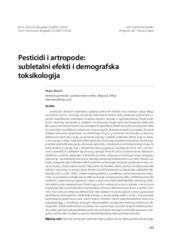Pesticides and Arthropods: Sublethal Effects and Demographic Toxicology
Pesticidi i artropode: subletalni efekti i demografska toksikologija
| dc.contributor.author | Marcic, Dejan | |
| dc.date.accessioned | 2015-10-31T18:05:23Z | |
| dc.date.available | 2015-10-31T18:05:23Z | |
| dc.identifier.uri | http://arhiva.nara.ac.rs/handle/123456789/1278 | |
| dc.description.abstract | Insecticides and acaricides designed to control primary harmful insects and mites may also variously affect some other arthopods present in an (agro)ecosystem (e.g. secondary pests, predators, parasitoids, saprophytes, bioindicators, pollinators). Apart from insecticides and acaricides, arthropods may also be affected by the activity of other pesticides (fungicides, herbicides, etc.). Regardless of whether they are deemed desirable or not, the effects that pesticides have on arthopods need to be quantified as closely as possible through appropriate experimental procedures. Data acquired in tests designed to determined LD50/LC50 values are inadequate for evaluation of pesticide effectiveness in the field as pesticides also cause various sublethal effects, generally disregarded in such investigations. The sublethal effects of pesticides refer to any altered behaviour and/or physiology of individuals that have survived exposure to pesticides at doses/concentrations that can be lethal (within range causing mortality in an experimental population that exceeds mortality in an untreated population) or sublethal (below that range). Pesticides affect locomotion and mobility, stimulate dispersion of arthropods from treated areas, complicate or prevent their navigation, orientation and ability to locate hosts, and cause changes in their feeding, mating and egg-laying patterns. Sublethal pesticide effects on arthropod physiology reflect on the life span, rate of development, fecundity and/or fertility, sex ratio and immunity of surviving individuals. Different parameters are being used in arthropod bioassays to determine sublethal effects (ED50/EC50, LOEC, NOEC, total effect index). Compared to acute toxicity tests, these parameters improve the quality of evaluation and create a more accurate view of the effects of a pesticide. However, such approach covers mainly fecundity/fertility alone, while all other sublethal effects remain unaccounted for. Besides, it refers to an evaluation of individuals, rather than populations, and it is the latter that are required for a more reliable evaluation of effectiveness of pesticides in real life. A demographic-toxicological approach has been proposed therefore as a way of integrating the effects that a toxicant may cause at population level, which includes the construction of life tables and computation of population growth parameters, including intrinsic rate of increase (rm) as a crucial parameter. Compared to other laboratory toxicity tests, the demographic-toxicological bioassay has been found superior in terms of a capacity to evaluate overall effects of pesticides, and such approach in evaluating pesticide effects is crucial for environmentally-based programmes of integrated plant protection and a competent evaluation of ecotoxicological risks of pesticide applications. | en |
| dc.description.abstract | Insekticidi i akaricidi namenjeni suzbijanju primarnih štetnih vrsta insekata i grinja deluju na različite načine i na druge artropode (sekundarne štetne vrste, predatore, parazitoide, saprofite, bioindikatore, polinatore) sa kojima dolaze u kontakt u (agro)ekosistemu. Pored insekticida i akaricida, artropode su osetljive i na delovanje drugih pesticida (fungicida, herbicida). Bez obzira da li ih posmatramo kao poželjne ili nepoželjne, efekte pesticida na artropode treba što preciznije kvantifikovati primenom odgovarajućih eksperimentalnih postupaka. Rezultati dobijeni testovima dizajniranim za određivanje LD50/LC50 vrednosti nisu dovoljni za procenu efektivnosti pesticida u polju, jer pesticidi izazivaju i različite subletalne efekte, koje ovi testovi ne uzimaju u obzir. Subletalni efekti pesticida obuhvataju promene ponašanja i/ili fiziologije jedinki preživelih ekspoziciju delovanju pesticida u dozama/koncentracijama koje mogu da budu letalne (u opsegu koji u eksperimentalnoj populaciji uzrokuje smrtnost veću od smrtnosti u kontroli) ili subletalne (ispod ovog opsega). Pesticidi utièu na lokomotornu aktivnost i mobilnost, podstiču disperziju sa tretiranih površina, otežavaju ili onemogućavaju navigaciju, orijentaciju i pronalaženje domaćina, menjaju ponašanje karakteristično za način ishrane, parenje i polaganje jaja. Subletalni efekti pesticida na fiziologiju atropoda ispoljavaju se kroz uticaj na dužinu života, brzinu razviæa, fekunditet i/ili fertilitet, odnos polova, imunitet preživelih jedinki. U testovima sa artropodama, koriste se razlièiti parametri za iskazivanje subletalnih efekata (ED50/EC50, LOEC, NOEC, indeks totalnog efekta). U poređenju sa testovima akutne toksičnosti, ovi parametri poboljšavaju kvalitet evaluacije i pružaju jasniju sliku o efektima pesticida; međutim, ovakav pristup uglavnom uzima u obzir samo fekunditet/fertilitet, dok drugi subletalni efekti ostaju neregistrovani. Pored toga, reč je o evaluaciji na nivou jedinke, a ne na nivou populacije, kakva je neophodna za pouzdaniju procenu efektivnosti pesticida u realnim uslovima. Kao način za integraciju efekata koje neki toksikant može da izazove na nivou populacije predložen je demografsko-toksikološki pristup, tj. konstruisanje tablica života i izračunavanje parametara populacionog rasta, među kojima centralno mesto pripada prirodnoj stopi rasta populacije (rm). U poređenju sa drugim laboratorijskim postupcima testiranja toksičnosti, demografsko- toksikološki biotest se pokazao kao superiorniji u proceni ukupnih efekata pesticida; ovakav pristup evaluaciji efekata pesticida suštinski je značajan za ekološki zasnovanu integralnu zaštitu bilja i kvalitetnu procenu ekotoksikološkog rizika primene pesticida. | sr |
| dc.subject | Pesticides | en |
| dc.subject | Arthropods | en |
| dc.subject | Sublethal effects | en |
| dc.subject | Life tables | en |
| dc.subject | Demographic toxicology | en |
| dc.subject | Pesticidi | sr |
| dc.subject | artropode | sr |
| dc.subject | subletalni efekti | sr |
| dc.subject | tablice života | sr |
| dc.subject | demografska toksikologija | sr |
| dc.title | Pesticides and Arthropods: Sublethal Effects and Demographic Toxicology | en |
| dc.title.alternative | Pesticidi i artropode: subletalni efekti i demografska toksikologija | sr |
Files in this item
This item appears in the following Collection(s)
-
VOL 22 *No.3
http://www.pesting.org.rs/2007.php



